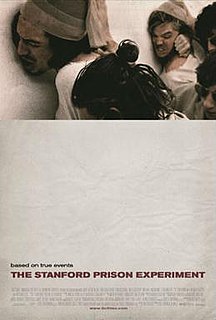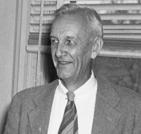Related Research Articles

The Milgram experiment(s) on obedience to authority figures was a series of social psychology experiments conducted by Yale University psychologist Stanley Milgram. They measured the willingness of study participants, men from a diverse range of occupations with varying levels of education, to obey an authority figure who instructed them to perform acts conflicting with their personal conscience. Participants were led to believe that they were assisting an unrelated experiment, in which they had to administer electric shocks to a "learner." These fake electric shocks gradually increased to levels that would have been fatal had they been real.

Stanley Milgram was an American social psychologist, best known for his controversial experiment on obedience conducted in the 1960s during his professorship at Yale.

The Stanford prison experiment (SPE) was a social psychology experiment that attempted to investigate the psychological effects of perceived power, focusing on the struggle between prisoners and prison officers. It was conducted at Stanford University on the days of August 14–20, 1971 by a research group led by psychology professor Philip Zimbardo using college students. In the study, volunteers were assigned to be either "guards" or "prisoners" by the flip of a coin, in a mock prison, with Zimbardo himself serving as the superintendent. Several "prisoners" left mid-experiment, and the whole experiment was abandoned after six days. Early reports on experimental results claimed that students quickly embraced their assigned roles, with some guards enforcing authoritarian measures and ultimately subjecting some prisoners to psychological torture, while many prisoners passively accepted psychological abuse and, by the officers' request, actively harassed other prisoners who tried to stop it. The experiment has been described in many introductory social psychology textbooks, although some have chosen to exclude it because its methodology is sometimes questioned.
Obedience, in human behavior, is a form of "social influence in which a person yields to explicit instructions or orders from an authority figure". Obedience is generally distinguished from compliance, which is behavior influenced by peers, and from conformity, which is behavior intended to match that of the majority. Depending on context, obedience can be seen as moral, immoral, or amoral.

Philip George Zimbardo is an American psychologist and a professor emeritus at Stanford University. He became known for his 1971 Stanford prison experiment, which was later severely criticised for both ethical and scientific reasons. He has authored various introductory psychology textbooks for college students, and other notable works, including The Lucifer Effect, The Time Paradox, and The Time Cure. He is also the founder and president of the Heroic Imagination Project.

The University of Akron is a public research university in Akron, Ohio. It is part of the University System of Ohio. As a STEM-focused institution, it focuses on industries such as polymers, advanced materials, and engineering.

The National Museum of American History: Kenneth E. Behring Center collects, preserves, and displays the heritage of the United States in the areas of social, political, cultural, scientific, and military history. Among the items on display is the original Star-Spangled Banner. The museum is part of the Smithsonian Institution and located on the National Mall at 14th Street and Constitution Avenue NW in Washington, D.C.

The Oakland Museum of California or OMCA is an interdisciplinary museum dedicated to the art, history, and natural science of California, located adjacent to Oak Street, 10th Street, and 11th Street in Oakland, California. The museum contains more than 1.8 million objects dedicated to "telling the extraordinary story of California." It was created in the mid-1960s out of the merger of three separate museums dating from the early 20th century, and was opened in 1969.
Deindividuation is a concept in social psychology that is generally thought of as the loss of self-awareness in groups, although this is a matter of contention (resistance). Sociologists also study the phenomenon of deindividuation, but the level of analysis is somewhat different. For the social psychologist, the level of analysis is the individual in the context of a social situation. As such, social psychologists emphasize the role of internal psychological processes. Other social sciences, such as sociology, are more concerned with broad social, economic, political, and historical factors that influence events in a given society.

Lester A. Lefton is an American academic and higher education administrator. He was the President of Kent State University (2006–2014). He has 35 years of experience in higher education, having served for 25 years at a public institution and nine at private institutions. During his career, he has been a psychology professor, dean and provost, as well as a psychology textbook author.
Under the controversy of person–situation debate, situationism is the theory that changes in human behavior are factors of the situation rather than the traits a person possesses. Behavior is believed to be influenced by external, situational factors rather than internal traits or motivations. Situationism therefore challenges the positions of trait theorists, such as Hans Eysenck or Raymond B. Cattell. This is an ongoing debate that has truth to both sides, psychologists are able to prove each of the view points through human experimentation.
Compliance refers to a response—specifically, a submission—made in reaction to a request. The request may be explicit or implicit. The target may or may not recognize that they are being urged to act in a particular way.
Christina Maslach is an American social psychologist and professor emerita of psychology at the University of California, Berkeley, known for her research on occupational burnout. She is a co-author of the Maslach Burnout Inventory and Areas of Worklife Survey. Early in her professional career, Maslach was instrumental in stopping the Stanford prison experiment.
The Summit County Historical Society of Akron, Ohio, abbreviated SCHS, is a 501(c)(3) non-profit organization located in Akron, Ohio. It focuses on the history of the City of Akron and Summit County, Ohio.
A social experiment is a kind of psychological or sociological research for testing people’s reaction to certain situations or events. The experiment relies on a particular social approach, when a main source of information is people with their own knowledge and point of view. To carry out a social experiment, specialists usually divide participants into two groups — active participants and respondents. Throughout the period of experiment, participants are monitored by specialists to identify the effects and differences as a result of the experiment.

The Stanford Prison Experiment is a 2015 American docudrama thriller film directed by Kyle Patrick Alvarez, written by Tim Talbott, and starring Billy Crudup, Michael Angarano, Ezra Miller, Tye Sheridan, Keir Gilchrist, Olivia Thirlby, and Nelsan Ellis. The plot concerns the 1971 Stanford prison experiment, conducted at Stanford University under the supervision of psychology professor Philip Zimbardo, in which students play the role of either a prisoner or prison guard.

Walter Richard Miles was an American psychologist and a president of the American Psychological Association (APA). He best known for his development of the two-story rat maze, his research on low dose alcohol, the development of red night vision goggles for aviation pilots, and the reduction of performance in aging individuals. However, the theme of his academic career was his fascination with apparatuses to measure behavior. C. James Goodwin (2003) noted that Miles "never became a leading figure in any particular area of research in psychology... but drifted from one area to another, with the direction of the drift determined often by the presence of a particular type of apparatus or an apparatus-related problem that intrigued him" (p. 58).

The Lucifer Effect: Understanding How Good People Turn Evil is a 2007 book which includes professor Philip Zimbardo's first detailed, written account of the events surrounding the 1971 Stanford Prison Experiment (SPE) — a prison simulation study which had to be discontinued after only six days due to several distressing outcomes and mental breaks of the participants. The book includes over 30 years of subsequent research into the psychological and social factors which result in immoral acts being committed by otherwise moral people. It also examines the prisoner abuse at Abu Ghraib in 2003, which has similarities to the Stanford experiment. The title takes its name from the pious story of the favored angel of God, Lucifer, his fall from grace, and his assumption of the role of Satan, the embodiment of evil. The book was briefly on The New York Times Non-Fiction Best Seller and won the American Psychological Association's 2008 William James Book Award.
References
- ↑ "History and Mission" at AHAP Archived June 6, 2009, at the Wayback Machine Retrieved August 27, 2010.
- ↑ "The Collection" at AHAP Archived April 6, 2009, at the Wayback Machine Retrieved March 4, 2009
- ↑ Zimbardo (Apparatus Collection) at AHAP Archived June 10, 2011, at the Wayback Machine Retrieved on March 4, 2009
- ↑ Shock Generator (Apparatus Collection) at AHAP Archived June 10, 2011, at the Wayback Machine Retrieved on March 4, 2009
- ↑ 'Wallbreaking' at psychology archives Retrieved August 27, 2010
- ↑ Spirited growth of UA continues as five new projects make their debut this fall Retrieved August 27, 2010
- ↑ Center for the History of Psychology to open Aug. 30 Retrieved August 27, 2010